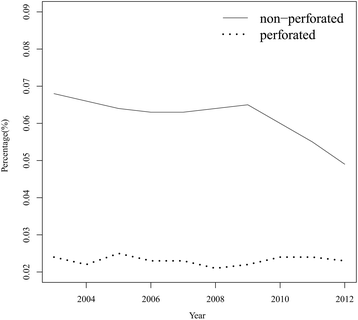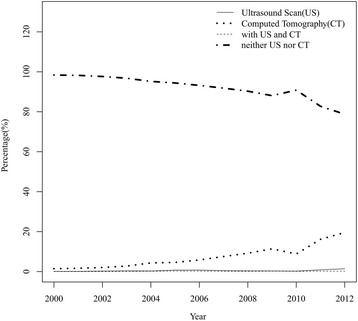Trends in diagnostic approaches for pediatric appendicitis: nationwide population-based study
- PMID: 29100501
- PMCID: PMC5670701
- DOI: 10.1186/s12887-017-0940-7
Trends in diagnostic approaches for pediatric appendicitis: nationwide population-based study
Abstract
Background: To define the benefits of different methods for diagnosis of pediatric appendicitis in Taiwan, a nationwide cohort study was used for analysis.
Methods: We identified 44,529 patients under 18 years old who had been hospitalized with a diagnosis of acute appendicitis between 2003 and 2012. We analyzed the percentages of cases in which ultrasound (US) and/or computed tomography (CT) were performed and non-perforated and perforated appendicitis were diagnosed for each year. Multivariate logistic regression analyses were performed to evaluate risk factors for perforated appendicitis.
Results: There were more cases of non-perforated appendicitis (N = 32,491) than perforated appendicitis (N = 12,038). The rate of non-perforated cases decreased from 0.068% in 2003 to 0.049% in 2012; perforated cases remained relatively stable at 0.024%~0.023% from 2003 to 2012. The percentage of CT evaluation increased from 3% in 2003 to 20% in 2012; the rates of US or both US and CT evaluations were similar annually. The percentage of neither CT nor US evaluation gradually decreased from 97% in 2003, to 79% in 2012. The odds ratios of a perforated appendix for those patients diagnosed by US, CT, or both US and CT were 1.227 (95% confidence interval (CI) 0.91, 1.65; p = 0.173), 2.744 (95% CI 2.55, 2.95; p < 0.001), and 5.062 (95% CI = 3.14, 8.17; p < 0.001), respectively, compared to patients who did not receive US or CT. The odd ratios of a perforated appendix for those patients 7-12 and ≤6 years old were 1.756 (95% CI 1.67, 1.84; p < 0.001) and 3.094 (95% CI 2.87, 3.34; p < 0.001), respectively, compared to those 13-18 years old.
Conclusions: Our study demonstrated that using CT scan as a diagnostic tool for acute appendicitis increased annually; most patients especially those ≤6 years old who received CT evaluation had a greater risk of having perforated appendicitis. We recommend a prompt appendectomy in those pediatric patients with typical clinical symptoms and physical findings for non-complicated appendicitis to avoid the risk of appendiceal perforation.
Keywords: Appendicitis; Computed tomography; National Health Insurance Database; Ultrasound.
Conflict of interest statement
Ethics approval and consent to participate
The NHI database used in this study consists of anonymous secondary data released to the public for research purposes. This study did not contain confidential patient data. Taipei Medical University-Joint Institutional Review Board approved this study (No: 201,404,074). The patient’s consent to participate is not applicable in this study.
Consent for publication
Not applicable.
Competing interests
The authors declare that they have no competing interests.
Publisher’s Note
Springer Nature remains neutral with regard to jurisdictional claims in published maps and institutional affiliations.
Figures
Similar articles
-
National trends in therapeutic approaches and outcomes for pediatric appendicitis: a Taiwanese nationwide cohort study.Pediatr Surg Int. 2015 Jul;31(7):647-51. doi: 10.1007/s00383-015-3718-8. Epub 2015 May 19. Pediatr Surg Int. 2015. PMID: 25985878
-
Diagnostic imaging practices for children with suspected appendicitis evaluated at definitive care hospitals and their associated referral centers.J Pediatr Surg. 2016 Jun;51(6):912-6. doi: 10.1016/j.jpedsurg.2016.02.055. Epub 2016 Mar 2. J Pediatr Surg. 2016. PMID: 26995518
-
Hospital type predicts computed tomography use for pediatric appendicitis.J Pediatr Surg. 2019 Apr;54(4):723-727. doi: 10.1016/j.jpedsurg.2018.05.018. Epub 2018 May 29. J Pediatr Surg. 2019. PMID: 29925468
-
The diagnosis of acute appendicitis in a pediatric population: to CT or not to CT.J Pediatr Surg. 2003 Mar;38(3):367-71; discsussion 367-71. doi: 10.1053/jpsu.2003.50110. J Pediatr Surg. 2003. PMID: 12632351 Review.
-
CT scans may not reduce the negative appendectomy rate in children.J Pediatr Surg. 2004 Jun;39(6):886-90; discussion 886-90. doi: 10.1016/j.jpedsurg.2004.02.034. J Pediatr Surg. 2004. PMID: 15185219 Review.
Cited by
-
Case report on a misleading case of appendiceal perforation presented with severe generalized convulsion.Transl Pediatr. 2020 Feb;9(1):81-85. doi: 10.21037/tp.2020.02.01. Transl Pediatr. 2020. PMID: 32154140 Free PMC article.
-
Clinical course in children with equivocal appendicitis on computed tomography: a retrospective cohort study.Ann Surg Treat Res. 2023 Jan;104(1):51-59. doi: 10.4174/astr.2023.104.1.51. Epub 2023 Jan 2. Ann Surg Treat Res. 2023. PMID: 36685769 Free PMC article.
-
sB7H3 in Children with Acute Appendicitis: Its Diagnostic Value and Association with Histological Findings.J Immunol Res. 2020 Sep 1;2020:2670527. doi: 10.1155/2020/2670527. eCollection 2020. J Immunol Res. 2020. PMID: 32953890 Free PMC article.
References
MeSH terms
LinkOut - more resources
Full Text Sources
Other Literature Sources
Medical



